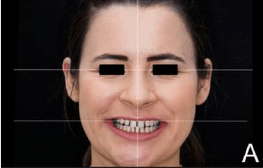ABSTRACT
The primary aim of aesthetic dental procedures is to meet patients’ expectations by enhancing facial and smile aesthetics. Over the past two decades, smile design has evolved from two-dimensional techniques to advanced three-dimensional, computer-aided approaches. Digital Smile Design (DSD) has become a prominent tool in this transformation, allowing clinicians to digitally plan and simulate smile enhancements before beginning actual treatment. DSD enables patients to visualize proposed outcomes and actively participate in the design process, resulting in personalized and satisfactory aesthetic solutions. Various digital smile design software platforms are now widely used in clinical practice, offering increased accuracy and efficiency in treatment planning. Research supports the effectiveness of DSD in improving patient communication, clinical predictability, and overall treatment outcomes. By integrating patient preferences with functional and anatomical considerations, DSD enhances both the diagnostic and procedural phases of aesthetic dentistry. This article aims to review the current evidence on the role of Digital Smile Design in cosmetic dentistry, highlighting its advantages in delivering tailored, predictable, and patient-centered outcomes.
Background: Traditionally, aesthetic dentistry relied on visual judgment, manual sketches, and diagnostic wax-ups on plaster models. These methods were time-consuming and subjective. With the advent of digital photography and CAD/CAM technology, dentistry began incorporating digital workflows. The Digital Smile Design (DSD) concept was first introduced by Dr. Christian Coachman in the early 2000s, combining photography, video, and software tools to analyse facial and dental proportions.
Conclusion: DSD is not just a technological tool but a comprehensive philosophy of esthetic dentistry that emphasizes personalization, accuracy, and predictability, and it continues to evolve with Artificial Intelligence, virtual reality, and advanced digital tools shaping the future of dental practice.
Key Word: Digital Smile Design; Aesthetic dentistry; CAD-CAM; Artificial Intelligence.
1.Introduction
In the rapidly advancing field of cosmetic dentistry, Digital Smile Design (DSD) has emerged as a transformative approach, offering a significant improvement over traditional smile design technique. This digital methodology has reshaped the way clinicians and patients approach aesthetic dental treatment by emphasizing personalization and predictability. A key strength of DSD lies in its integration of advanced imaging technologies, which facilitate a comprehensive analysis of both facial and dental structures. This enables clinicians to design smiles that are not only functionally sound but also harmoniously aligned with the patient’s unique facial features. Unlike conventional techniques that depend largely on the clinician’s subjective assessment, DSD offers an objective, data-driven approach to treatment planning. Patients benefit from the ability to visualize a digital simulation of the anticipated outcome before the commencement of any clinical procedure. This visual communication enhances patient understanding, sets realistic expectations, and significantly improves treatment acceptance and satisfaction. By bridging the gap between clinical expertise and patient perception, DSD contributes to more predictable and patient-centered outcomes in aesthetic dentistry. Communication barriers between the dental practitioner and the patient can be a significant hurdle in conventional methods and treatment planning in dentistry relied on subjective assessments, often leading to miscommunication between dentists and patients regarding the desired outcome1. DSD bridges this gap effectively by presenting visual and understandable treatment plans, it fosters a profound understanding and collaboration. Patients become active participants in their smile design process, leading to more informed decisions and a higher level of trust. This enhanced communication fosters a stronger dentist-patient relationship and increases patient satisfaction.
One of the key advantages of Digital Smile Design (DSD) is its minimally invasive nature. Unlike traditional techniques, which may involve extensive tooth preparation or rely on subjective estimations, DSD offers a highly precise and conservative approach. This accuracy reduces the need for unnecessary tooth reduction, thereby preserving the natural tooth structure to the greatest extent possible. DSD’s digital workflow also enhances clinical efficiency. With detailed planning and visualization, treatment procedures are often faster and require fewer appointments, resulting in reduced chair time and a more convenient experience for patients. Moreover, the digital platform facilitates the seamless integration of various dental specialties—such as orthodontics, prosthodontics, and periodontics—into a single, cohesive treatment plan. This interdisciplinary collaboration ensures a holistic approach that addresses both functional and aesthetic aspects of oral health. Overall, DSD represents a significant advancement in cosmetic dentistry. Its emphasis on individualized care, effective communication, minimally invasive treatment, and interdisciplinary coordination has made it a preferred approach for both clinicians and patients. As the technology continues to evolve, DSD is poised to further elevate the standards and outcomes of aesthetic dental care.
By utilizing specialized software and advanced imaging techniques, DSD enables dental professionals to analyse and modify the patient’s dental and facial proportions, ultimately designing a smile that is harmonious with the patient’s unique features3. This digital approach ensures greater precision and predictability in achieving optimal aesthetic outcomes.
Software’s used in DSD
This article compares the possibilities of some of the most popular DSD programs to evaluate and digitally alter facial, dento-gingival, and dental smile aesthetic criteria. The softwares included in this observation include Adobe Systems Incorporated’s Photo Shop CS6, Apple Inc.’s Keynote, Tasty Tech Ltd.’s, Smile Designer Pro (SDP), Dr. Valerio Bini’s Aesthetic Digital Smile Design (ADSD), Sirona Dental Systems Inc.’s Cerec SW 4.2, Planmeca Romexis Smile Design (PRSD), Web Motion LTD’s VisagiSMile, and Coachman’s DSD App (DSDApp LLC). Although Keynote and Photoshop CS6 were not developed especially for DSD, dentists and other dental professionals have used them as DSD programs, and literature studies have indicated that they are recommendable for usage in the cosmetic dentistry applications. SDP and ADSD are promoted as specialised design tools for use in the cosmetic dentistry industry. The CAD/CAM programs Cerec SW 4.2 and PRSD may be utilized to create anterior restorations; to construct ceramic restorations, frontal photos and intraoral digital impressions could be needed. VisagiSMile and DSD App both utilize the visagism principle, which hypothesizes that temperament might influence smile design. Through the utilization of Keynote for the smile design, Coachman has also developed the DSD App. Because of their increased versatility and range of functions, programs designed for applications beyond dentistry are anticipated to have a larger reach. Every dental, dentogingival, and facial analysis aspect present in the examined DSD was examined using Photoshop CS6. Although Keynote could analyse every parameter, it was incapable to generate and alter the tooth surface’s subtle anatomic features4. Numerous features for dental, dentogingival assessment and planning are included in the Cerec SW 4.2, ADSD, DSD App, SDP, PRSD, and VisagiSMile packages. A set of pre-existing tooth grids that are overlaid on to the patient’s teeth acts as the basic foundation for the programs. By directly altering the grid’s tooth size, shape, and color, the user gets a direct control over the finished pattern. The DSD App and SDP platforms are compatible with mobile phone interfaces which enable portability and direct image uploading. Three-dimensional smile designs can be created with Cerec SW 4.2, PRSD, and DSD App. Additionally, interim and permanent restorations that mimic the intended smile can be created using Cerec SW4.2 and PRSD in conjunction with CAD/CAM.
In 2023, Chisnoiu et al. conducted an observational study in which they processed Standard Tessellation Language (STL) images and initial smile evaluation photos using 3Shape Dental System Software (Copenhagen, Denmark). This software makes it possible to analyze, superimpose, and process dental pictures and images, which helps with aesthetic evaluation and comparing traditional and digital techniques. In a 2021 study, Ortensi et al.6 also used the 3Shape 3D Viewer software to assess the manufacturing of personalized composite veneers. To verify the clinical suitability of prosthetic components, this software helps with the viewing and analysis of 3D dental plans in addition to the comparison of linear measures and finished veneers. In order to construct computer-aided rapid loading of implants, Cattoni et al. used Smile Lynx CAD software (88Dent, Pero, Lombardy, Italy) in their 2021 study. 3D-DSP prosthetic dental restorations, namely poly methyl methacrylate (PMMA) mock-ups, were made using a CAD/CAM technology.

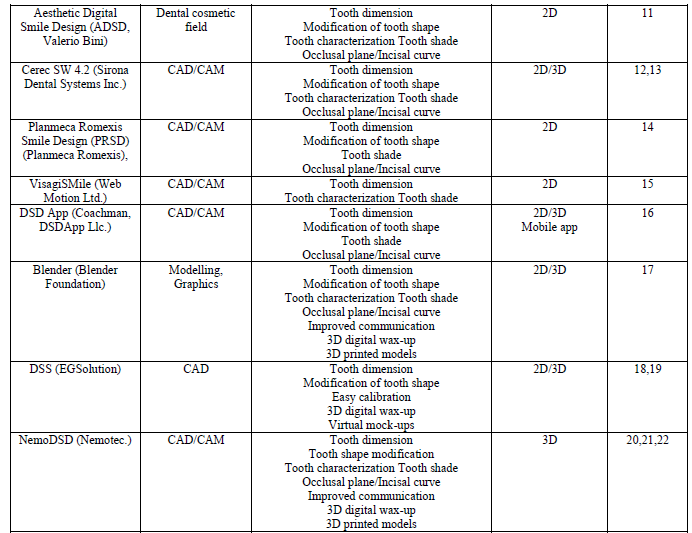
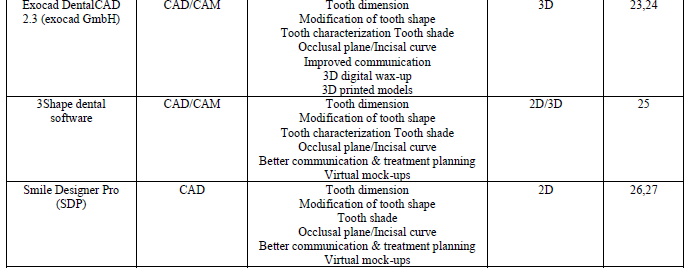
Key components of DSD
1.Digital imaging
The first step in DSD is the collection of high-quality digital images, usually radiographs, intraoral scans, and photos of the face. These pictures form the basis for analysis and therapy planning (Table no 2: 1A)
2.Smile design
Dentists can create various smile designs and adjustments by manipulating digital images with specialized software. To establish a balanced and aesthetically beautiful smile, this stage entails assessing the patient’s facial and dental proportions and making necessary changes (Table no 2: B, C).
3.Mock-up and wax-up
To give the patient a concrete depiction of the suggested modifications, a physical mock-up or wax-up is made after the optimal smile design has been decided. This enables the patient to see the outcome and offer input prior to the start of treatment.
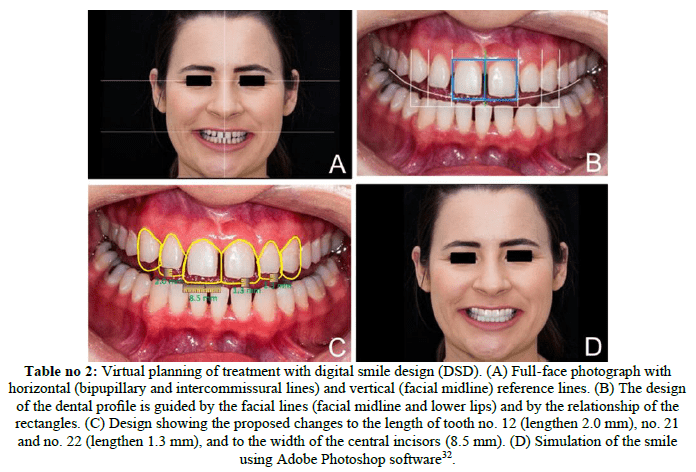
4.Communication and collaboration
Effective communication between the interdisciplinary team, the dentist, and the dental laboratory is facilitated by DSD. When working on complicated situations requiring orthodontics, periodontics, or prosthodontics, the digital files may be transferred easily, guaranteeing precise information transfer and cooperation.
5.Patient presentation
DSD enables dentists to use digital photographs and mock-ups to show patients the suggested course of treatment. Patients are better able to set reasonable expectations, comprehend anticipated results, and actively engage in the decision-making process thanks to this visual aid (Table no 2: 1D)
6.Restoration fabrication and delivery
Restorative material can be fabricated using modern technologies like CAD-CAM or 3D-Printing followed by try-in and cementation (Table no 3).
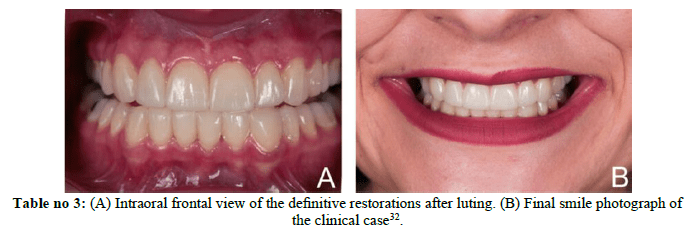
Digital smile design benefits for communication and treatment planning
1.Visualizing the outcome
Before beginning any therapy, DSD enables patients and dentists to see the desired outcome. By helping the patient take part in the decisions regarding their dental care, this visualization helps match their expectations with the treatment procedure (Table no 2: 1D)
2.Enhanced communication
Dentists can address concerns, explain suggested improvements, and effectively convey treatment plans to patients by using DSD. This open dialogue guarantees a common knowledge of the intended result, builds trust, and lowers concern34.
3.Predictability and precision
With DSD, dentists can design treatments with more accuracy and predictability. Through digital picture manipulation, they can optimize the final restoration’s functional and aesthetic elements by fine-tuning the design and analysing numerous options.
4.Interdisciplinary collaboration
DSD makes it easier for various dental professionals to work together on a holistic treatment plan. Better treatment outcomes are accomplished through effective collaboration and made possible by efficient interaction and sharing of digital materials.
5.Patient satisfaction
As DSD involves patients in the treatment planning process, it has a great positive impact on patient satisfaction. Patients feel empowered and secure in their choices because they are aware of their opinions and preferences are respected and taken into account.
6.Time and cost efficiency
DSD reduces the need for several edits and remakes, which expedites the treatment process. Chairside time and the total cost of treatment are decreased by the fidelity and predictability that digital planning offers.
2. Conclusions
The application of DSD in restorative dentistry offers many advantages and applicability. Communicating with the patient and estimating the approximate outcome is crucial since it increases their sense of confidence and encouragement. Since the intended result can be expressed clearly, interaction with the dental laboratory personnel is also far more efficient. The ability of various DSD programs to generate a complete digital smile that take into account aesthetic factors relevant to the face, dentogingival area, and teeth is made clear by comparing them. The research discussed in this review brings focus on to the clinical suitability of finished prosthetic components made using digital systems, as well as the possible advantages of the reliability and less-invasive aspect of 3D digital smile planning approaches. To keep up with the latest developments in DSD and guarantee its successful application in dental practice, ongoing research and training are crucial.
Source
https://www.iosrjournals.org/iosr-jdms/papers/Vol24-issue8/Ser-6/D2408061318.pdf
References
[1].Cervino, G. Et Al. Antibiotic Prophylaxis On Third Molar Extraction: Systematic Review Of Recent Data. Antibiotics 8, 53 (2019).
[2].Thomas, P. A. Et Al. Digital Smile Design. J Pharm Bioallied Sci 14, S43–S49 (2022).
[3].Coachman, C., Calamita, M. A., Coachman, F. G., Coachman, R. G. & Sesma, N. Facially Generated And Cephalometric Guided 3D Digital Design For Complete Mouth Implant Rehabilitation: A Clinical Report. J Prosthet Dent 117, 577–586 (2017).
[4].Coachman, C. & Calamita, M. Digital Smile Design: A Tool For Treatment Planning And Communication In Esthetic Dentistry. Quintessence Of Dental Technology (QDT) 35, 103 (2012).
[5].Chisnoiu, A. M. Et Al. Smile Design And Treatment Planning—Conventional Versus Digital—A Pilot Study. J Pers Med 13, 1028 (2023).
[6].Ortensi, L. Et Al. Digital Planning Of Composite Customized Veneers Using Digital Smile Design: Evaluation Of Its Accuracy And Manufacturing. Clin Exp Dent Res 8, 537–543 (2022).
[7].Cattoni, F. Et Al. Digital Smile Designed Computer-Aided Surgery Versus Traditional Workflow In “All On Four” Rehabilitations: A Randomized Clinical Trial With 4-Years Follow-Up. Int J Environ Res Public Health 18, 3449 (2021).
[8].Sundar, M. K. & Venkataraman Chelliah, B. D. S. Ten Steps To Create Virtual Smile Design Templates With Adobe Photoshop CS6. Compendium 39, (2018).
[9].Naffah, N., Ounsi, H., Ozcan, M. & Salameh, Z. Evaluation Of The Color Stability Of Three Resin-Ceramic Materials Using A Spectrophotometer And A Digital Photography Software. Contemp Clin Dent 15, 44–50 (2024).
[10].Zotti, F. Et Al. Traditional, 2D And 3D Workflows: What Is Better For Aesthetic Rehabilitation Of Superior Anterior Teeth? Applied Sciences 13, 6205 (2023).
[11].Bini, V. Aesthetic Digital Smile Design: Software-Aided Aesthetic Dentistry: Part I. CAD/CAM Int. Mag. Digital Dent 2, 12–17 (2014).
[12].Chitlange, P. M., Madhu, P. P. & Reche, A. Digital Smile Design-An Overview Of 3D Digital Workflow. J. Clinical And Diagnostic Res 17, (2023).
[13].Mullick, T., Purayil, T. P. & Pentapati, K. C. Smile Design Software: A Virtual Avenue To Treatment Planning. Int J Dentistry Oral Sci 8, 4864–4868 (2021).
[14].Dai, Q., Davis, R., Hong, H. & Gu, Y. Effectiveness Of Self-Assessment Software To Evaluate Preclinical Operative Procedures. Arxiv Preprint Arxiv:2404.05865 (2024).
[15].GORRIPATI, J. P. & GODBOLE, S. D. Creating Smiles With Digital Workflow And Matrix Transfer Technique In Customizing Personality-Based Smile Designing. International Arab Journal Of Dentistry 15, 199–206 (2024).
[16].Do Vale Voigt, M. Et Al. Dsdapp Use For Multidisciplinary Esthetic Planning. Journal Of Esthetic And Restorative Dentistry 32, 738–746 (2020).
[17].Galibourg, A. & Brenes, C. Virtual Smile Design Tip: From 2D To 3D Design With Free Software. The Journal Of Prosthetic Dentistry 121, 863–864 (2019).
[18].Sanchez-Lara, A. Et Al. Comprehensive Digital Approach With The Digital Smile System: A Clinical Report. J Prosthet Dent 121, 871–875 (2019).
[19].Ahmed, M. Et Al. From Conventional To Virtual Smile Design Systems: A Current Systematic Review. Preprint At Https://Doi.Org/10.20944/Preprints202104.0572.V1 (2021).
[20].Alshali, S. & Asali, R. Conventional And Digital Workflow Planning For Maxillary Teeth Restoration With Porcelain Laminate Veneers: A Clinical Report. Clin Cosmet Investig Dent 14, 45–53 (2022).
[21].Piedra‐Cascón, W., Fountain, J., Att, W. & Revilla‐León, M. 2D And 3D Patient’s Representation Of Simulated Restorative Esthetic Outcomes Using Different Computer‐Aided Design Software Programs. Journal Of Esthetic And Restorative Dentistry 33, 143–151 (2021).
[22].Ahmed, W. M. Et Al. Mapping The Landscape Of The Digital Workflow Of Esthetic Veneers From Design To Cementation: A Systematic Review. Dent J (Basel) 12, 28 (2024).
[23].Sarhan, M. M., Khamis, M. M., Abdelhamid, A. M. & Ezzelarab, S. Evaluation Of The Virtual Cement Gap Parameter Of Different CAD Software Programs In Designing A Single Crown Restoration: An In Vitro Study. J Prosthet Dent 129, 777.E1-777.E7 (2023).
[24].Lo Giudice, A. Et Al. The Step Further Smile Virtual Planning: Milled Versus Prototyped Mock-Ups For The Evaluation Of The Designed Smile Characteristics. BMC Oral Health 20, 165 (2020).
[25].ÖLÇER US, Y., YÜZBAŞIOĞLU, E., ALBAYRAK, B. & ÖZDEMİR, G. Digital Smile Design : Predictable Results. J Exp Clin Med 38, 123–128 (2021).
[26].Thomas, P. A. Et Al. Digital Smile Design. J Pharm Bioallied Sci 14, S43–S49 (2022).
[27].Jafri, Z., Ahmad, N., Sawai, M., Sultan, N. & Bhardwaj, A. Digital Smile Design-An Innovative Tool In Aesthetic Dentistry. J Oral Biol Craniofac Res 10, 194–198 (2020).
[28].Coachman, C. Et Al. The Influence Of Tooth Color On Preparation Design For Laminate Veneers From A Minimally Invasive Perspective: Case Report. International Journal Of Periodontics & Restorative Dentistry 34, 453–459 (2014).
[29].Yankov, B. Et Al. Software Application For Smile Design Automation Using The Visagism Theory. In Proceedings Of The 17th International Conference On Computer Systems And Technologies 2016 237–244 (ACM, New York, NY, USA, 2016). Doi:10.1145/2983468.2983521.
[30].Cervino, G., Fiorillo, L., Arzukanyan, A. V., Spagnuolo, G. & Cicciù, M. Dental Restorative Digital Workflow: Digital Smile Design From Aesthetic To Function. Dent J (Basel) 7, 30 (2019).
[31].Alharkan, H. M. Integrating Digital Smile Design Into Restorative Dentistry: A Narrative Review Of The Applications And Benefits. Saudi Dent J 36, 561–567 (2024).
[32].GONTIJO, S. M. De L. Et Al. Digital Smile Design As A Tool In The Planning Of Porcelain Laminate Veneers Restoration. RGO – Revista Gaúcha De Odontologia 69, (2021).
[33].Ortensi, L. Et Al. Digital Planning Of Composite Customized Veneers Using Digital Smile Design: Evaluation Of Its Accuracy And Manufacturing. Clin Exp Dent Res 8, 537–543 (2022).
[34].Bini, V. Aesthetic Digital Smile Design: Software-Aided Aesthetic Dentistry: Part I. CAD/CAM Int. Mag. Digital Dent 2, 12–17 (2014).
[35].De AS Levi, Y. L., Cota, L. V. De S. & Maia, L. P. Digital Smile Design For Gummy Smile Correction. Indian Journal Of Dental Research 30, 803–806 (2019).
[36].Coachman, C. & Calamita, M. Digital Smile Design: A Tool For Treatment Planning And Communication In Esthetic Dentistry. Quintessence Of Dental Technology (QDT) 35, (2012).
[37].Whiteman, Y. Y. A Communication Guide For Orthodontic-Restorative Collaborations: Digital Smile Design Outline Tool. Dent Clin North Am 64, 719–730 (2020).
[38].Levrini, L., Tieghi, G. & Bini, V. Invisalign Clincheck And The Aesthetic Digital Smile Design Protocol. J Clin Orthod 49, 518–524 (2015).

